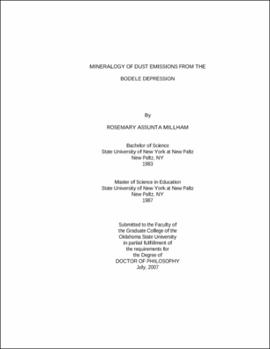| dc.contributor.advisor | Marks, Steven Ken | |
| dc.contributor.author | Millham, Rosemary Assunta | |
| dc.date.accessioned | 2013-11-26T08:29:51Z | |
| dc.date.available | 2013-11-26T08:29:51Z | |
| dc.date.issued | 2007-07 | |
| dc.identifier.uri | https://hdl.handle.net/11244/7113 | |
| dc.description.abstract | Scope and Method of Study: This study focused on identifying the minerals in the dust emitted from the Bodele Depression in northern Chad in the Saharan Desert. Understanding the mineralogy provides the information needed to assess the effects that mineral dust has on climate and climate change relative to the energy budget and radiative forcings, and cloud characteristics and properties, and assists in providing critical information for assessing amounts of nutrients delivered to oceans and lands. There is a question of health issues related to dust emissions not addressed in this study. | |
| dc.description.abstract | Using a traditional X-Ray diffractometer (XRD), scanning electron microscope (SEM) with chemical analysis capabilities, French geological survey maps, and a new instrument for detecting d-spacings and K-fluorescence in unprepared samples called the XRD XRF (CCDXRD) that couples a CCD with traditional X-Ray diffractometer, mineral identification is possible. | |
| dc.description.abstract | Findings and Conclusions: The samples from the Bodele in situ aerosol and bulk ground materials produce the dust emissions occurring from the region ~40% of the days in a year. The results from literature review, X-Ray diffractometer data, SEM data, geological survey maps, and the CCD XRD data provided concrete identification of the Bodele minerals as typical crustal silicate minerals with small amounts of calcium carbonate, dolomite, silica, desiccated diatoms, and possible iron oxides. The silicate minerals are primarily ferromagnesian and framework silicates typical of low-lying depositional basins and the weathering processes occurring in alternating wet and dry periods. Clays minerals halloysite, kaolinite, and smectites (montmorillite) are the most common. | |
| dc.description.abstract | Exotic materials were detected in two of the bulk samples. A reading of 25.75% titanium in one sample, and elevated isolated silicon data (considered cosmic silicon) provided the only anomalies in the study. | |
| dc.format | application/pdf | |
| dc.language | en_US | |
| dc.rights | Copyright is held by the author who has granted the Oklahoma State University Library the non-exclusive right to share this material in its institutional repository. Contact Digital Library Services at lib-dls@okstate.edu or 405-744-9161 for the permission policy on the use, reproduction or distribution of this material. | |
| dc.title | Mineralogy of dust emissions from the Bodele Depression | |
| dc.contributor.committeeMember | Beller-Fye, Caroline | |
| dc.contributor.committeeMember | Stadler, Stephen John | |
| dc.contributor.committeeMember | Vitek, John D. | |
| osu.filename | Millham_okstate_0664D_2360 | |
| osu.accesstype | Open Access | |
| dc.type.genre | Dissertation | |
| dc.type.material | Text | |
| dc.subject.keywords | bodele | |
| dc.subject.keywords | aerosols | |
| dc.subject.keywords | mineralogy | |
| thesis.degree.discipline | Environmental Science | |
| thesis.degree.grantor | Oklahoma State University | |
